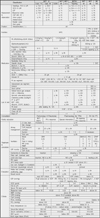Abstract
Purpose
This study is a descriptive research to analyze prognostic factors of barbiturate coma therapy (BCT) for severe brain damage patients, to develop a critical pathway (CP) based on the results of analysis and to examine the effect of its clinical application.
Method
We analyzed medical records of 76 patients who received BCT for more than three days between January 1999 to July 2005. Based on the results of the analysis, we developed a CP and applied it to 12 people during August-December of 2005.
Result
By application of BCT CP, the mortality rate decreased from 31.6% to 16.7%. It was found that the period of staying at ICU and total period of hospitalization were shortened by 2.78 (13.9%) days and 16.43 (29.4%) days, respectively. The Glasgow coma scale of the recovery group by CP application was 9.03 (4.64) at 72 hours post of BCT and 14.28 (1.82) at discharge from hospital, and DRS was 6.62 (6.38) points.
Figures and Tables
Figure 1
Critical pathway of barbiturate coma therapy
[Abbreviations] A/C and D/B=Active coughing and Deep breathing; AFO=Ankle foot orthopedic; B/S=Bowel sound; BST=Blood sugar test; N/S=Normal saline; CPP=Cerebral perfusion pressure; CSF=Cerebrospinal fluid; CVP=Central venous pressure; DVT=Deep vein thrombosis; EVD=External ventricular drainage; GCS=Glasgow coma scale; I/O=Intake/Output; IPC=Intermittent pneumatic compressor; L/M=Limb motor; L/R=Light reflex; MBP=Mean blood pressure; ND=Natural drainage; Pb=Pentobarbital; PEEP=Positive end expiratory pressure; P/S=Pupil size; RH=Rehabilitation; R/V=Residual volume. T/P=T-piece; USG=Urine specific gravity.

References
1. Beare P, Myers J. Clinical correlates of compensated and uncompensated phase of intracranial hypertension. Principle and practice of adult nursing. 1990. ed 1. St Louis: Mosby.
2. Beyea SC. Critical pathways for collaborative nursing care. 1996. New York: Addison-Wesley Nursing, A division of the Benjamin/Cummings Publishing.
3. Bingaman WE, Frank JI. Malignant cerebral edema and intracranial hypertension. Neurol Clin. 1995. 13(3):479–509.

4. Blaylock B, Murray M. Case management: A new practices model for ET nurses. J Wound Ostomy Continence Nurs. 1996. 23(2):66–72.
5. Bledsoe KA, Kramer AH. Propylene glycol toxicity complicating use of barbiturate coma. Neurocrit Care. 2008. 9(1):122–124.

6. Bullock R, Chesnut RM, Clifton G, Ghajar J, Marion DW, Narayan RK, et al. Guidelines for the management of severe head injury. Brain Trauma Foundation. Eur J Emerg Med. 1996. 3(2):109–127.
7. Chen HI, Malhotra NR, Oddo M, Heuer GG, Levine JM, LeRoux PD. Barbiturate infusion for intractable intracranial hypertension and its effect on brain oxygenation. Neurosurgery. 2008. 63(5):880–886. discussion 886-887.

8. Chung KH, Joo JL, Chung HS. The effect of Critical Pathway on the patients with Cesarean section. J Korean Acad Nurs Adm. 2000. 6(2):211–225.
9. Dereeper E, Berre J, Vandesteene A, Lefranc F, Vincent JL. Barbiturate coma for intracranial hypertension: Clinical observations. J Crit Care. 2002. 17(1):58–62.

10. Espinosa-Aguilar A, Reyes-Morales H, Huerta-Posada CE, de León IL, López-López F, Mejía-Hernández M, et al. Design and validation of a critical pathway for hospital management of patients with severe traumatic brain injury. J Trauma. 2008. 64:1327–1341.

11. Finfer SR, Ferch R, Morgan MK. Barbiturate coma for severe, refractory vasospasm following subarachnoid haemorrhage. Intensive Care Med. 1999. 25(4):406–409.

12. Foley N, Marshall S, Pikul J, Salter K, Teasell R. Hypermetabolism following moderate to severe traumatic acute brain injury: A systematic review. J Neurotrauma. 2008. 25(12):1415–1431.

13. Gardetto NJ, Greaney K, Arai L, Brenner A, Carroll KC, Howerton NM, et al. Critical pathway for the management of acute heart failure at the veterans affairs San Diego healthcare system: Transforming performance measures into cardiac care. Crit Pathw Cardiol. 2008. 7:153–172.

14. Ghajar J, Hariri RJ, Narayan RK, Iacono LA, Firlik K, Patterson RH. Survey of critical care management of comatose, head-injured patients in the United States. Crit Care Med. 1995. 23(3):560–567.

15. Hong SO. A study on the development and application of critical pathway in Korea. 2000. Seoul: Hanyang University;Unpublished master's thesis.
16. Jantzen JP. Prevention and treatment of intracranial hypertension. Best Pract Res Clin Anaesthesiol. 2007. 21(4):517–538.

17. Jeevaratnam DR, Menon DK. Survey of intensive care of severely head injured patients in the United Kingdom. Bmj. 1996. 312(7036):944–947.

18. Kim JS. Development of a critical pathway and its application for the management of subarachnoid hemorrhage. J Korean Data Anal Soc. 2010. 12(1):1–16.
19. Kim YI, Park SW, Nam TK, Park YS, Min BK, Hwang SN. The effect of barbiturate coma therapy for the patients with severe intracranial hypertension: a 10-year experience. J Korean Neurosurg Soc. 2008. 44(3):141–145.

20. Kokoska ER, Smith GS, Pittman T, Weber TR. Early hypotension worsens neurological outcome in pediatric patients with moderately severe head trauma. J Pediatr Surg. 1998. 33(2):333–338.

21. Korean Neurosurgical Society. Neurosurgery: Increased intracranial pressure. 2004. 3rd ed. Seoul:
22. Lee MW, Deppe SA, Sepperly ME, Marrette RR, Thompson DR. The efficacy of barbiturate coma in the management of uncontroll the intracranial hypertension following neurosurgical trauma. J Neurotrauma. 1994. 11(3):325–331.

23. Nussbaum E, Maggi JC. Pentobarbital therapy does not improve neurologic outcome in nearly drowned, flaccid-comatose children. Pediatrics. 1988. 81(5):630–634.

24. Orliaguet GA, Meyer PG, Baugnon T. Management of critically ill children with traumatic brain injury. Paediatr Anaesth. 2008. 18(6):455–461.

25. Pearson SD, Goulart-Fisher D, Lee TH. Critical pathways as a strategy for improving care problems and potential. Ann Intern Med. 1995. 123.

26. Rappaport M, Hall KM, Hopkins K, Belleza T, Cope DN. Disability rating scale for severe head trauma: coma to community. Arch Phys Med Rehabil. 1982. 63(3):118–123.
27. Roberts I. Barbiturates for acute traumatic brain injury. Cochrane Database Syst Rev. 2000. (2):CD000033.

28. Roh JS. Development of a Critical Pathway for Patients with Lobectomy and Pneumonectomy. J Korean Acad Nurs Adm. 2004. 10(3):345–364.
29. Sung YH. Development of A Case management model and its application(for the laminectomy patients). 2000. Seoul: Chung-Ang University;Unpublished doctoral dissertation.
30. Zander K. Nursing case management: Strategic management of cost and quality outcomes. J Nurs Adm. 1988. 18(5):23–30.




 PDF
PDF ePub
ePub Citation
Citation Print
Print







 XML Download
XML Download